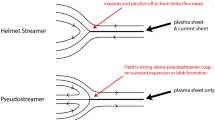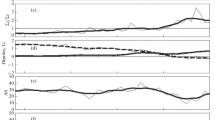Abstract
When observed at soft X-ray wavelengths coronal holes are seen as open features, devoid of X-ray emission and bounded by apparently divergent coronal loop structures. Inspection of the topology of the photospheric magnetic fields associated with these features suggests that holes are formed when the remnants of active region fields, emerging in both hemispheres over a period of several solar rotations, combine to form a large area of essentially unipolar field. Remnants of opposite polarity fields surround these features resulting in a divergent magnetic configuration at the hole boundaries. Holes are seen to form and evolve while the large scale divergent field pattern is reinforced and to close when large scale remnants occur which disrupt the general field pattern. Two types of holes are observed in the early Skylab observations. The first are elongated features which are aligned approximately north-south extending from one solar pole to a polar filament channel in the opposite hemisphere. The polar holes and somewhat lower latitude holes appear to lie in unipolar areas which are completely confined by opposite polarity fields.
Studies of the rotation properties of an elongated hole, which extended from the north pole to a latitude of approximately 20° S, showed it to rotate with a synodic rate of (13.25±0.03)−(0.4±0.1 sin2φdeg day−1. Possible explanations for the almost rigid rotational characteristics of this feature are discussed.
Similar content being viewed by others
References
Altschuler, M. D., Trotter, D. E. and Orrall, F. Q.: 1972, Solar Phys. 26, 354.
Antonucci, E. and Svalgaard, L.: 1974, Solar Phys. 34, 3.
Babcock, H. W.: 1961, Astrophys. J. 133, 572.
Bumba, V. and Howard, R.: 1969, Solar Phys. 7, 28.
Dodson-Prince, H. W. and Hedeman, E. R. : 1968, in K. O. Kiepenheuer (ed.), ‘Structure and Development of Solar Active Regions’, IAU Symp. 35, 56.
Dulk, G. A. and Sheridan, K. V.: 1974, Solar Phys. 36, 191.
Golub, L., Krieger, A. S., Silk, J. K., Timothy, A. F., and Vaiana, G. S.: 1974, Astrophys. J. 189, L93.
Hansen, R. T., Hansen, S. F., and Loomis, H. G.: 1969, Solar Phys. 10, 135.
Harvey, J., Krieger, A. S., Timothy, A. F., and Vaiana, G. S.: 1974, ‘Comparison of Skylab X-ray and Ground Based Helium Observations’, to be published in the Proceedings of the Working Session on the Preliminary Results of the Skylab Solar Experiments and Correlated Ground Observations, Arcetri Astrophysical Observatory, Florence, Italy.
Krieger, A. S., Timothy, A. F., and Roelof, E. C.: 1973, Solar Phys. 29, 505.
Krieger, A. S., Timothy, A. F., Vaiana, G. S., Lazarus, A. J., and Sullivan, J. D.: 1974, in Proceedings of the Third Solar Wind Conference at Asilomar Conference Grounds, California.
Leighton, R. B.: 1964, Astrophys. J. 140, 1547.
Munro, R. H. and Withbroe, G. L.: 1972, Astrophys. J. 176, 511.
Neupert, W. M. and Pizzo, V.: 1974, to be published in J. Geophys. Res.
Newkirk, G. A.: 1967, Ann. Rev. Astron. Astrophys. 5, 213.
Newkirk, G., Jr., Trotter, D. E., Altschuler, M. D., and Howard, R.: 1973. ‘A Microfilm Atlas of Magnetic Fields in the Solar Corona’, NCAR Technical Note, NCAR-TN/STR-85.
Newton, H. W. and Nunn, M. L.: 1951, Monthly Notices Roy. Astron. Soc. 111, 413.
Pneuman, G. W.: 1971, Solar Phys. 19, 16.
Svalgaard, L.: 1972, J. Geophys. Res. 77, 4027.
Švestka, Z.: 1968, Solar Phys. 4, 18.
U.S. Department of Commerce, Environmental Science Services Administration: 1973, Solar Geophyscial Data, pp. 345–7.
Vaiana, G. S., Krieger, A. S., and Timothy, A. F.: 1973a, Solar Phys. 32, 81.
Vaiana, G. S., Davis, J. M., Giacconi, R., Krieger, A. S., Silk, J. K., Timothy, A. F., and Zombeck, M.: 1973b, Astrophys. J. 185, L47.
Van Speybroeck, L. P., Krieger, A. S., and Vaiana, G. S.: 1970, Nature 227, 818.
Weber, E. J.: 1969, Solar Phys. 9, 150.
Weber, E. J. and Davis, L., Jr.: 1967, Astrophys. J. 148, 217.
Wilcox, J. M. and Howard, R.: 1970, Solar Phys. 13, 251.
Wilcox, J. M. and Tannenbaum, A. S.: 1971, Space Sci. Lab. Rep. Ser. 12.
Wilcox, J. M., Schatten, K. H., Tannenbaum, A. S., and Howard, R.: 1970, Solar Phys. 14, 255.
Author information
Authors and Affiliations
Additional information
Harvard College Observatory - Smithsonian Astrophysical Observatory.
Rights and permissions
About this article
Cite this article
Timothy, A.F., Krieger, A.S. & Vaiana, G.S. The structure and evolution of coronal holes. Sol Phys 42, 135–156 (1975). https://doi.org/10.1007/BF00153291
Received:
Revised:
Issue Date:
DOI: https://doi.org/10.1007/BF00153291




